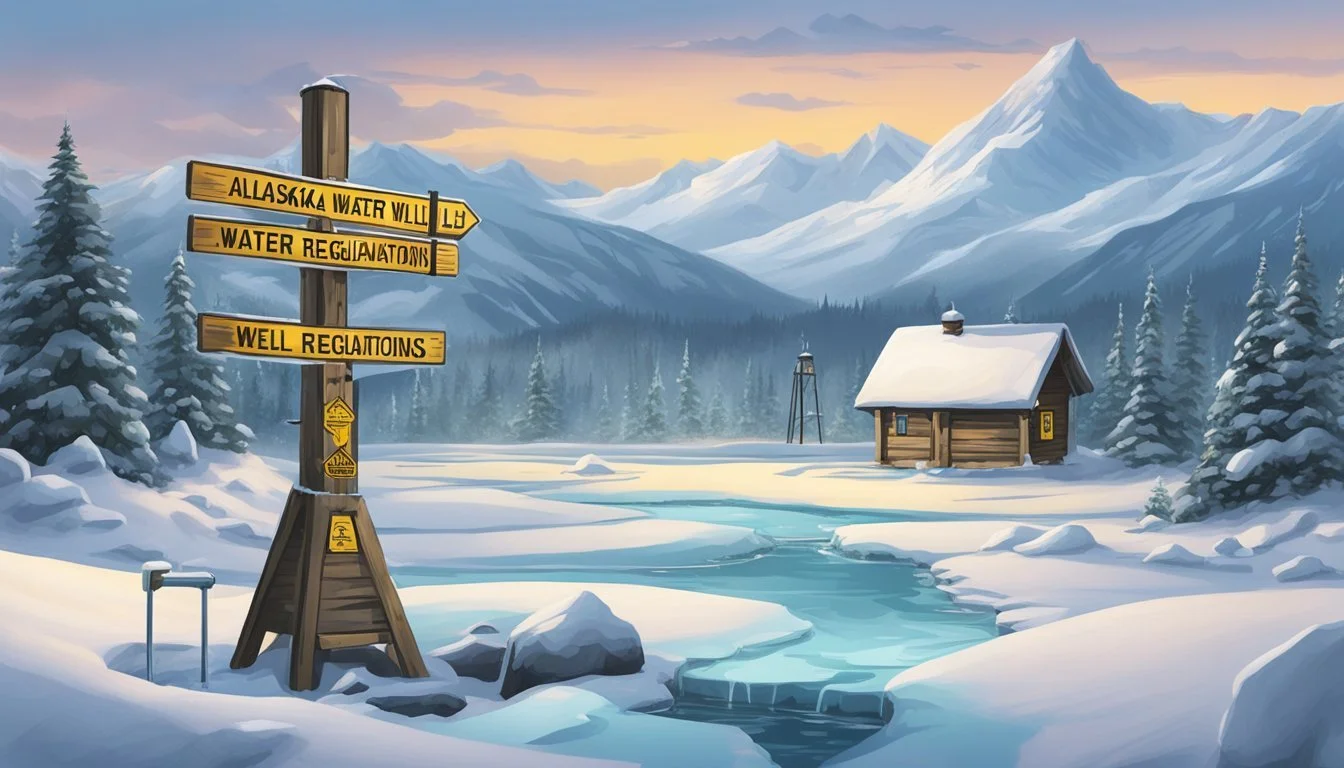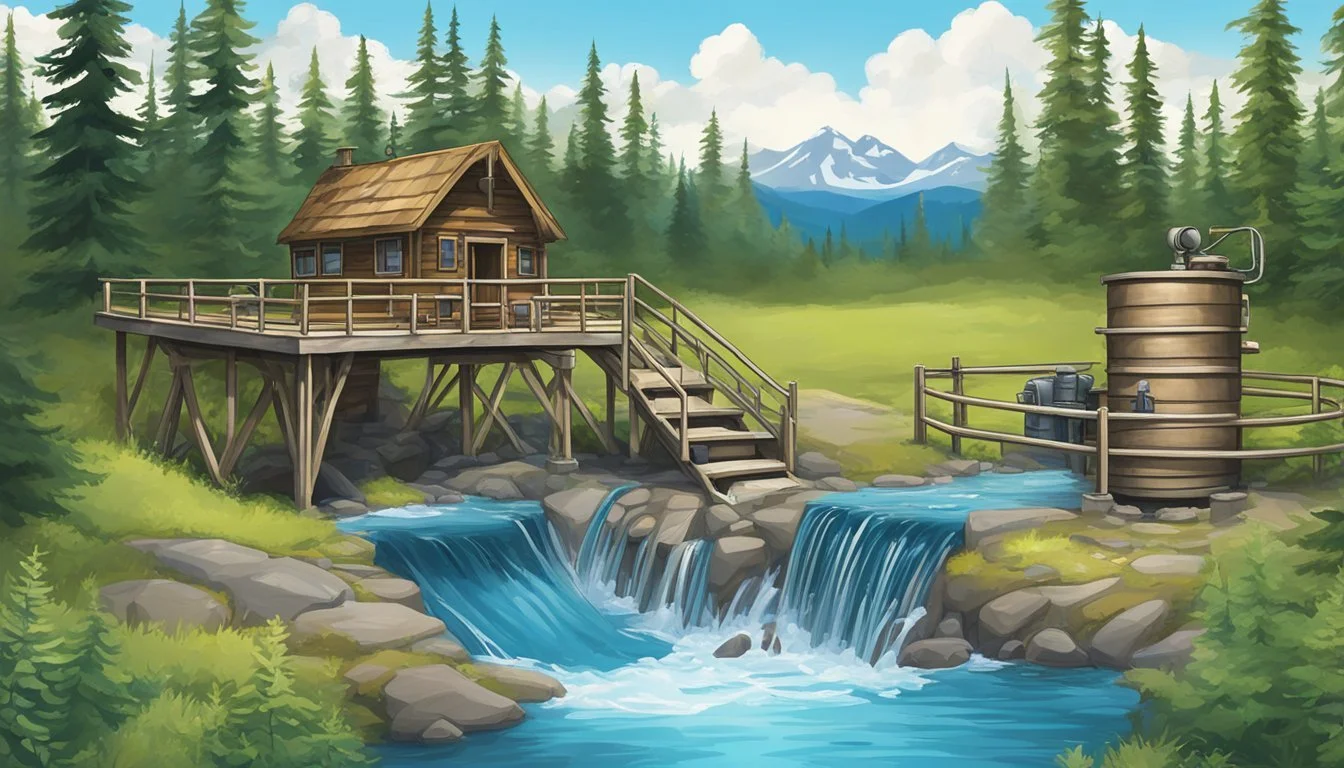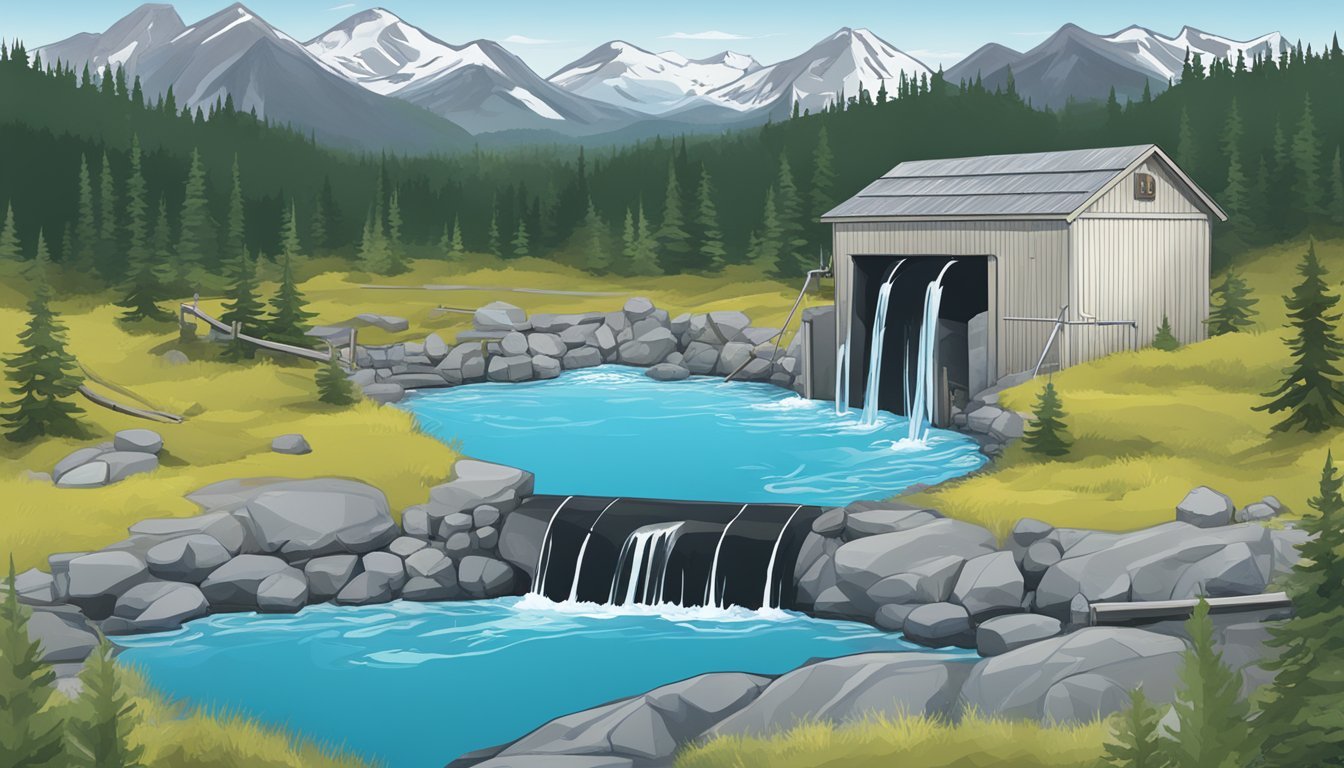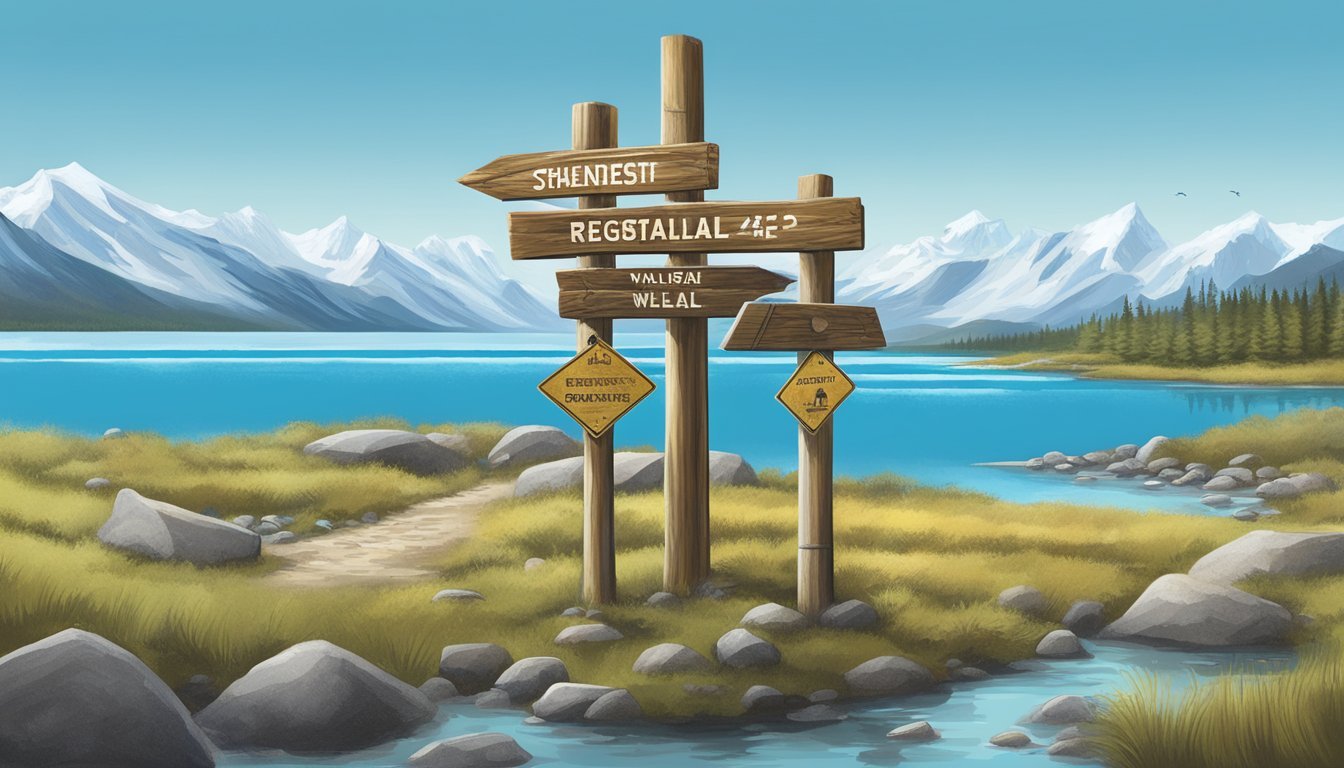Alaska Water Well Regulations
Understanding the Essentials for Compliance
Water well regulations in Alaska are designed to maintain the safety and integrity of private and public drinking water sources. As a vast state with a relatively low population density, many Alaskans rely on private wells for their drinking water. However, it's important to note that the State of Alaska, specifically the Drinking Water Program, does not regulate the construction of private drinking water wells, with a couple of exceptions. The only local governments that have established standards for the construction of private water wells are found in the Municipality of Anchorage and the City of North Pole.
For public water systems, the situation is different. These systems are regulated by the Alaska Department of Environmental Conservation (ADEC), Division of Environmental Health, Drinking Water Program, which requires public water systems to be in compliance with state regulations. These standards align with the Federal Safe Drinking Water Act and are set to protect the health of both residents and visitors. Adequate construction, maintenance, and operation of these systems are critical for ensuring the provision of safe water.
In Alaska, groundwater is a common source for many public water systems, due to its widespread availability. The ADEC provides guidance and support for small-untreated water systems serving fewer people, which do not add chemicals to their water supply. Best Management Practices (BMPs) have been developed for Alaskans to further safeguard groundwater quality and quantity, emphasizing the importance of proper well construction, maintenance, and decommissioning.
Alaska's Water Rights Framework
Alaska operates under a distinct set of regulations that dictate the utilization and stewardship of its water resources. Recognized by the state's constitution, water in Alaska is a public resource managed for maximizing public benefit.
Legal Right to Water
In Alaska, water is considered a public resource, and anyone seeking to use water on any land, whether public or private, must obtain legal Water Rights. Alaska's water law system is based on the doctrine of prior appropriation which means, "first in time, first in right." Essentially, this doctrine allows individuals with earlier water rights greater priority during times of shortage.
Water Rights Application Process
Individuals or entities must submit a Water Rights Application to the Alaska Department of Natural Resources to legally divert or withdraw water. This application process involves providing detailed information, which includes the purpose of water use, the quantity of water, and the method of diversion or withdrawal. A Water Rights Map may be consulted for existing water rights in the area.
Temporary Water Use Authorization
For short-term water needs that do not justify the need for a permanent water right, individuals may apply for Temporary Water Use Authorization. This allows for the temporary use of water in a manner that is consistent with the state's laws and regulations. The authorization is intended for purposes such as construction water supply or special events, ensuring that such short-term uses are regulated and monitored appropriately.
Regulatory Bodies and Legislation
In Alaska, water well regulations are enforced by several entities, ensuring that private and public water systems adhere to standards that maintain public health and environmental integrity. Two primary agencies play significant roles in water well regulations: the Department of Natural Resources (DNR) and the Department of Environmental Conservation (DEC).
Department of Natural Resources (DNR)
The Department of Natural Resources is responsible for managing all state-owned land, water, and natural resources in Alaska except for fish and game. When it comes to water wells, the DNR issues permits for water withdrawals and ensures that the use of water resources aligns with state statutes. Engineers and operators seeking to develop water wells must consult with DNR to secure water rights and adhere to the stipulated guidelines.
Function: Water rights management and permitting.
Key Personnel: Engineers, operators.
Department of Environmental Conservation (DEC)
The Department of Environmental Conservation oversees the quality and safety of public water systems through its Drinking Water Program. This program, managed by the Division of Environmental Health (EH), requires all Public Water Systems to comply with state drinking water regulations which harmonize with the Federal Safe Drinking Water Act. DEC provides best management practices for private water systems, guidelines for maintaining wells, and resources for well decommissioning.
Regulated Areas: Water system safety, water quality, best management practices.
Operators' Responsibility: Ensure water systems meet state and federal standards.
Resources: Private Drinking Water Wells & Systems BMPs, Drinking Water Regulations.
Through diligent regulation and oversight, these bodies work collectively to administer water well regulations, supporting sustainable practices and the health of Alaska's residents and its environment.
Water Well Construction and Maintenance
The construction and maintenance of water wells in Alaska requires adherence to specific regulatory measures to ensure the safety and integrity of drinking water sources. These measures are in place to protect groundwater from contamination and to guarantee water wells are constructed for optimal performance and longevity.
Permitting and Approval
Before well construction commences, a permit is often necessary. In Alaska, local governments in areas such as the Municipality of Anchorage and the City of North Pole have established standards for private water wells. They require permits to ensure the well site meets sanitary requirements and does not pose a risk of contamination. Permitting involves a detailed review process by regulatory bodies to ensure all plans for the well meet state and local guidelines for safety and construction.
Installation Guidelines
Water well contractors are responsible for following established installation guidelines to meet regulatory compliance. Proper installation is critical and includes selecting a safe location, away from potential contamination sources like flooding or waste systems. Quality materials for casing and sanitary seals are important to maintain the integrity and prevent pollutants from entering the water system. These components must be installed with precision to prevent the seepage of contaminants that can compromise water quality.
Maintenance Best Practices
Regular maintenance is required to uphold the sanitary conditions of water wells. Best practices include periodic inspection of the physical well structure and its components, such as sanitary seals and casing. Regular testing for water quality is also encouraged to detect any baseline shifts that might indicate contamination. Maintenance must be performed by or under the guidance of experienced water well contractors, ensuring that any repairs or enhancements are carried out in compliance with the relevant regulation and safeguarding against potential flooding and other environmental risks.
Water Well Decommissioning
In Alaska, the decommissioning of water wells is a structured process that must adhere to specific regulations to protect groundwater quality. The decommissioning must prevent contamination and ensure the long-term safety of unused wells.
Procedures for Decommissioning
To decommission a well in Alaska, one must follow a series of mandatory steps to prevent future contamination. It starts with eliminating potential contamination sources near the wellhead and ensuring a sanitary seal. The process involves the removal of all pumping equipment and the disconnection of power supplies. Subsequently, approved materials, such as grout, are used to fill the well, ensuring no pathways are left open that might allow water or contaminants to migrate between aquifers or to the surface. For detailed guidelines, residents can refer to the Best Management Practices for decommissioning water wells and boreholes provided by the state of Alaska.
Driller's Log Requirements
Maintaining an accurate driller's log is obligatory during the decommissioning process. The log must include specific details about the decommissioning procedure such as materials used, the amounts, and methods of placement. This record provides transparency and an audit trail to confirm that decommissioning meets Alaska's regulatory standards, protecting the integrity of groundwater resources. An official Well Record of Decommissioning form must be completed and submitted to the relevant state authorities. The detailed guidelines for maintaining the driller's log and the decommissioning procedures help ensure the long-term protection of the water supply and public health.
Water Quality and Protection
Alaska is committed to ensuring the safety and quality of its water through stringent regulations and standards. This framework is crucial for protecting public health and the state's diverse ecosystems.
Drinking Water Regulations
Alaska's Drinking Water Program administers the regulations that govern public water systems to ensure that they provide safe drinking water to the community. These regulations are in place for Community Water Systems, which serve the same people year-round, as well as Non-Transient Non-Community Water Systems serving the same people for at least six months a year, and Transient Non-Community Water System that do not meet the former criteria. Detailed information on the specifics of these regulations can be found on Alaska's Department of Environmental Conservation's website.
Contamination and Protection Standards
Alaska has set forth standards to prevent contamination and protect drinking water sources. The state has guidelines for Private Drinking Water Wells & Systems, including best management practices for location, construction, and source protection. These standards help to mitigate risks from environmental contaminants and ensure the provision of clean, potable water. For instance, Well Decommissioning Best Management Practices (BMPs) are implemented to prevent the contamination of groundwater when a well is no longer in use.
Testing and Laboratories
Regular testing of water quality is carried out by certified laboratories to detect the presence of drinking water contaminants. Laboratories conducting these tests must meet state and federal certification requirements to ensure accurate and reliable results. The Alaska Department of Environmental Conservation mandates regular testing schedules for various substances, and these facilities play a vital role in the Drinking Water Program, comprehensively overseeing water quality and reporting on the efficacy of protection standards.
Water Source Management
In Alaska, the management of water resources is a critical issue, encompassing both groundwater and surface water considerations, especially considering the state's unique environmental conditions and community needs.
Groundwater vs. Surface Water
Groundwater, found beneath the Earth's surface in aquifers, provides a major portion of Alaska's drinking water. In contrasts, surface water encompasses water from sources like rivers, lakes, and streams, which can be used for both consumption and recreation. While both are vital resources, groundwater is not regulated by the State of Alaska's Drinking Water Program when obtained through private wells, unlike public water systems that may draw from either.
Groundwater:
Often preferred for drinking due to filtration through soil and rock
Less susceptible to pollution than surface water
Requires careful well construction and decommissioning as outlined in Best Management Practices (BMPs)
Surface Water:
More affected by weather, human activity, and immediate environmental changes
Often the focal point for recreation activities
Typically requires more treatment before being safe for drinking
Public Water System Oversight
A public water system (PWS) is defined as a system that provides water for human consumption to at least 15 service connections or regularly serves at least 25 individuals. In Alaska, these public systems are regulated to ensure the protection and sustainable management of water resources. The State of Alaska's guidelines provide a framework for PWS to maintain the safety of both groundwater and surface water sources. Moreover, measures are implemented to protect water from contamination:
Protection Measures:
Regular updates of potential contamination sources
Defined criteria for well protection and source water protection
Implementation of impervious surfaces and control measures (18 AAC 80.015)
Public water systems monitor and manage these resources to balance human consumption needs with environmental conservation, as well as ensure the safety of water used for recreation and consumption.
Stakeholder Responsibilities
In Alaska, the responsibilities toward water well regulation are clearly defined for various stakeholders. Each plays a pivotal role in ensuring the safety and compliance of private drinking water wells and mining-related water systems.
Owner and Operator Duties
Owners and operators of private drinking water wells in Alaska are tasked with adhering to the Best Management Practices as provided by the state. They must ensure minimum separation distances from potential sources of contamination, particularly when related to on-site disposal systems. It is mandatory for an owner to engage certified installers for septic systems. Operators are responsible for routine maintenance and testing, making sure that the water supplied is safe for consumption and meets regulatory standards.
Contractor and Engineer Roles
Contractors in Alaska, including water well drillers and pump installers, must follow a set of Best Management Practices during the construction of non-public water wells. They collaborate with engineers, hydrologists, and state agencies to ensure that water well construction meets the regulatory requirements. Engineers play a crucial role in designing water systems that comply with the state's drinking water regulations, adhering to technical standards to prevent any risks associated with mining operations and other environmental hazards.
Documentation and Resources
Proper documentation is essential for compliance with Alaska's water well regulations. A wealth of resources is available to assist individuals and professionals throughout the process, from well planning to maintenance.
Available Forms and Documents
Alaska provides a comprehensive collection of forms and documents to guide the construction, maintenance, and decommissioning of water wells. These include, but are not limited to, applications for well construction, guidelines for maintaining water wells, and best management practices (BMPs). The Alaska Department of Environmental Conservation houses these forms and documents on their website, allowing for easy email and mail correspondence for submission and inquiry purposes.
Forms: Permit applications, notification forms, reporting forms
Resources: Well owner's guides, BMPs, decommissioning procedures
Key contacts for assistance and questions are also provided through the department's resources.
Well Log Tracking System
The Well Log Tracking System (WELTS) offers a digitized repository of well logs which contains crucial information such as latitude, longitude, maps, and details about the well's construction. This system provides an invaluable tool for both the Alaska Hydrologic Survey and the public, ensuring the management of water resources is based on accurate and up-to-date information. Entities such as the American Water Works Association (AWWA) and Drinking Water Watch also make use of the data for ensuring the quality and safety of drinking water. The WELTS system can be accessed online for both submission of new well logs and retrieval of existing records.
Tracking System Access: Online via the Alaska Department of Environmental Conservation
Information Included: Geographic coordinates, construction details, water quality reports
Additionally, WELTS is often updated with the latest news relevant to well owners, related to both regulatory changes and best practices in well maintenance.
Frequently Asked Questions
The following section addresses common inquiries regarding the regulations and processes associated with water wells in Alaska. These questions cover a range of topics, from construction requirements to testing protocols.
What are the legal requirements for constructing a water well in Alaska?
In Alaska, the construction of private water wells must adhere to specific legal standards, though the state does not regulate the construction itself. Private well owners are responsible for ensuring that their wells meet these standards.
How often is well water testing required in Alaska?
While the Alaska Drinking Water Program does not mandate regular testing for private wells, it is the responsibility of the owner to have their well water tested periodically to maintain water quality.
What are the minimum distance requirements for water well placement from property lines in Alaska?
The state has established minimum distance requirements for water well placement from property lines to prevent contamination. These can vary, so individuals should consult the relevant regulations or contact local authorities for specific requirements.
Where can one find the official Alaska water well regulations documentation?
The Alaska Drinking Water regulations can be found in a PDF format, offering a comprehensive guide for understanding the rules governing water wells in Alaska.
Who oversees the protection and management of groundwater in Alaska?
The State of Alaska's Drinking Water Program is responsible for the oversight of public water systems, as well as for setting regulations that protect the state's groundwater.
Is there a public database available for accessing water well logs in Alaska?
Yes, there is a public database that allows individuals to access water well logs in Alaska, providing valuable information on water quality and well status.











